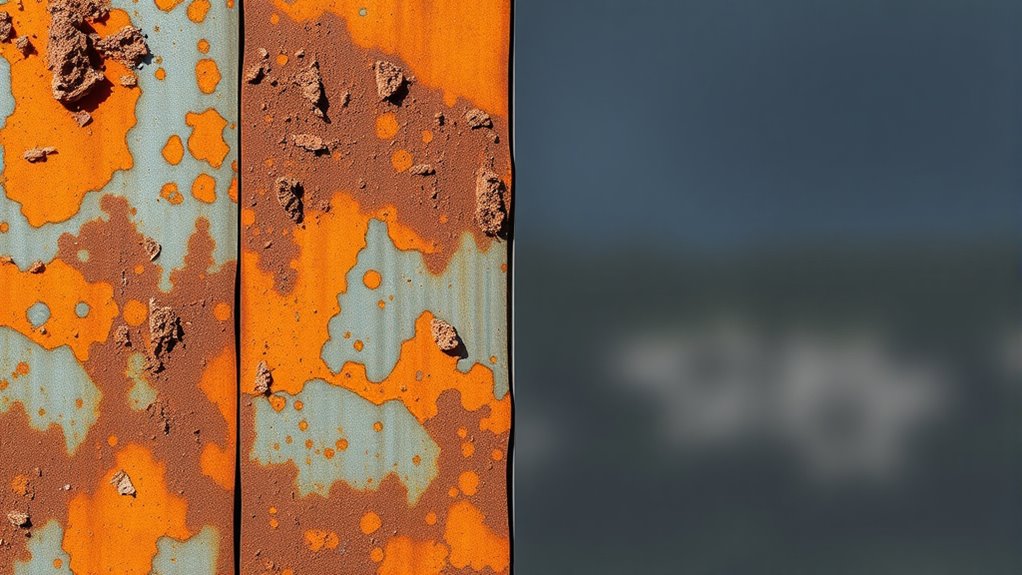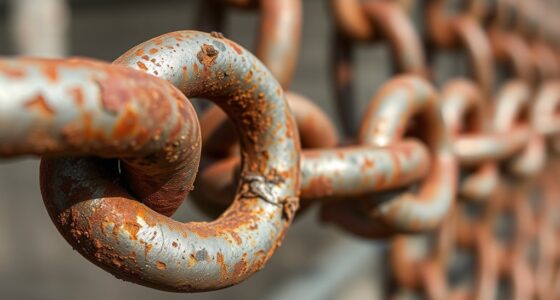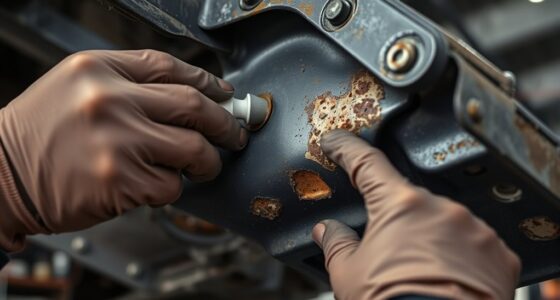Rust converters chemically transform existing rust into a stable, protective layer by reacting with iron oxide, stopping further corrosion. In contrast, rust inhibitors form a barrier that prevents rust from forming in the first place, blocking moisture and oxygen. If you’re dealing with rust already present, converters are your best bet. For ongoing protection against rust, inhibitors are more suitable. Want to discover how to choose the right option for your needs? Keep exploring!
Key Takeaways
- Rust converters chemically transform existing rust into a stable, inert layer, while inhibitors form a protective barrier without reacting with rust.
- Converters are ideal for treating rusted surfaces, whereas inhibitors prevent rust formation on clean, unrusted metal.
- Proper application of converters requires thorough cleaning and drying; inhibitors need a clean surface but are more forgiving.
- Converters provide a permanent chemical change, while inhibitors offer a temporary protective film for ongoing rust prevention.
- Use rust converters to stabilize rusted surfaces before painting, and inhibitors to maintain protection over time.

When it comes to protecting metal surfaces from rust, understanding the difference between rust converters and inhibitors is crucial. Rust converters work by triggering chemical reactions that transform existing rust into a stable, protective coating. They contain active ingredients, such as tannic acid or phosphoric acid, which react with the iron oxide (rust) to create a black or dark-colored barrier. This process effectively halts rust’s progression and prepares the surface for further treatment, like painting or sealing. The key to using rust converters successfully lies in understanding their application techniques. You need to thoroughly clean and dry the surface before applying the converter, ensuring it penetrates all rusted areas. Applying too thick a coat can hinder proper chemical reactions, so follow the manufacturer’s instructions carefully. Typically, brushes, rollers, or spray systems are used for application, depending on the surface’s size and texture. It’s important to allow adequate drying time after application, which can vary from a few hours to overnight, depending on the product. Proper application ensures the chemical reactions occur efficiently, converting rust into a stable, inert compound that adheres well to the metal.
In contrast, rust inhibitors don’t react chemically with rust but instead provide a protective barrier that prevents moisture and oxygen from reaching the metal surface. They are often applied as primers or sprays and contain compounds like oils, waxes, or phosphates that form a thin, invisible film. This film acts as a shield, blocking the chemical reactions necessary for rust formation. When you choose an inhibitor, you’re fundamentally creating a proactive layer that stops rust from developing in the first place. Application techniques for inhibitors vary but generally involve cleaning the surface thoroughly before spraying or brushing on the inhibitor. For best results, you should apply a uniform coat, ensuring complete coverage, especially in crevices and hard-to-reach spots. Like converters, inhibitors require proper drying time, and multiple coats might be necessary for long-term protection. Using inhibitors is particularly effective on surfaces that are exposed to harsh conditions or high humidity, where preventing rust is more feasible than reversing existing rust damage.
Frequently Asked Questions
Can Rust Converters Be Used on Painted Surfaces?
Yes, you can use rust converters on painted surfaces, but you need to consider painted surface compatibility. Rust converters work best on bare metal or rusted areas, and applying them over paint can limit their effectiveness. Keep in mind rust converter limitations, like not fully penetrating painted layers, which might prevent complete rust neutralization. Always test a small area first and follow the manufacturer’s instructions for ideal results.
How Long Do Rust Inhibitors Typically Last?
Like the timeless endurance of a classic masterpiece, rust inhibitors typically last 1 to 5 years, depending on product durability and application methods. You should regularly inspect the surface and reapply as needed to maintain protection. Proper surface preparation, such as cleaning and rust removal, enhances longevity. Keep in mind that environmental factors like moisture and salt can shorten their lifespan, so consider these when planning maintenance.
Are Rust Converters Environmentally Friendly?
Rust converters are generally not considered highly eco-friendly due to their chemical components, which can impact the environment if not properly disposed of. However, some eco-friendly options are available that minimize environmental impact, using natural or less toxic ingredients. When choosing a rust treatment, look for products with eco-friendly labels to reduce your environmental footprint. Always follow disposal instructions to prevent pollution and protect the environment.
Which Is More Cost-Effective Long-Term: Converters or Inhibitors?
You’ll find that rust inhibitors are more cost-effective long-term because they offer better application durability and easier application methods. While converters might seem cheaper initially, they often require reapplication and maintenance, adding up over time. Think of inhibitors as planting a seed—you nurture it once, and it grows strong. So, investing in inhibitors saves you money and effort, making them the smarter choice in the long run.
Do Rust Inhibitors Require Surface Preparation Before Application?
Yes, rust inhibitors typically require proper surface preparation before application. You should clean the surface thoroughly to remove dirt, grease, and loose rust, ensuring good surface adhesion. Use appropriate surface preparation techniques like sanding or wire brushing for ideal results. This step helps the inhibitor bond effectively, providing better protection. Skipping surface prep can compromise application techniques and reduce the inhibitor’s effectiveness, so take the time to prep the surface properly.
Conclusion
Choosing between rust converters and inhibitors is like picking the right shield for your metal. Rust converters transform existing rust into a protective layer, while inhibitors prevent rust from forming in the first place. Both are essential tools in your maintenance arsenal, but understanding your needs helps you make the best call. Think of it as a battle—know when to attack rust head-on or keep it from attacking your metal again. Stay proactive and protect your assets!















